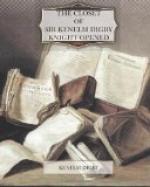Kenelm Digby owed a good deal to circumstances, but he owed most of all to his own rich nature. His family was ancient and honourable. Tiltons originally, they took their later name in Henry III’s time, on the acquisition of some property in Lincolnshire, though in Warwickshire and Rutland most of them were settled. Three Lancastrian Digby brothers fell at Towton, seven on Bosworth Field. To his grandfather, Sir Everard the philosopher, he was mentally very much akin, much more so than to his father, another of the many Sir Everards, and the most notorious one. Save for his handsome person and the memory of a fervent devotion to the Catholic faith, which was to work strongly in him after he came to mature years, he owed little or nothing to that most unhappy young man, surely the foolishest youth who ever blundered out of the ways of private virtue into conspiracy and crime. Kenelm, his elder son, born July 11, 1603, was barely three years old when his father, the most guileless and the most obstinate of the Gunpowder Plotters, died on the scaffold. The main part of the family wealth, as the family mansion Gothurst—now Gayhurst—in Buckinghamshire, came from Sir Everard’s wife, Mary Mulsho; and probably that is one reason why James I acceded to the doomed man’s appeal that his widow and children should not be reduced to beggary. Kenelm, in fact, entered on his active career with an income of L3000 a year; but even its value in those days did not furnish a youth of such varied ambitions and such magnificent exterior over handsomely for his journey through the world. His childhood was spent under a cloud. He was bred by a mother whose life was broken and darkened, and whose faith, barely tolerated, would naturally keep her apart from the more favoured persons of the kingdom. Kenelm might have seemed destined to obscurity; but there was that about the youth that roused interest; and even the timid King James was attracted by him into a magnanimous forgetfulness of his father’s offence. Nevertheless, he could never have had the easy destiny of other young men of his class, unless he had been content to be a simple country gentleman; and from the first his circumstances and his restless mind dictated his career, which had always something in it of the brilliant adventurer.
Another branch of the Digbies rose as the Buckinghamshire family fell. It was a John Digby, afterwards Earl of Bristol, who carried the news of the conspirators’ design on the Princess Elizabeth. King James’s gratitude was a ladder of promotion, which would have been firmer had not this Protestant Digby incurred the dislike of the royal favourite Buckingham. But in 1617 Sir John was English ambassador in Madrid; and it may have been to get the boy away from the influence of his mother and her Catholic friends that this kinsman, always well disposed towards him, and anxious for his advancement, took him off to Spain when he was fourteen, and kept him there for a year. Nor was his mother’s influence unmeddled with otherwise. During some of the years of his minority at least, Laud, then Dean of Gloucester, was his tutor. Tossed to and fro between the rival faiths, he seems to have regarded them both impartially, or indifferently, with an occasional adherence to the one that for the moment had the better exponent.




